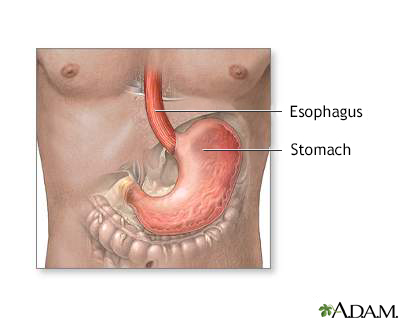Bernstein test
Acid perfusion test
The Bernstein test is a method to reproduce symptoms of heartburn. It is most often done with other tests to measure esophageal function.
Images

I Would Like to Learn About:
How the Test is Performed
The test is done in a gastroenterology laboratory. A nasogastric (NG) tube is passed through one side of your nose and into your esophagus. Mild hydrochloric acid will be sent down the tube, followed by salt water (saline) solution. This process may be repeated several times.
You will be asked to tell the health care team about any pain or discomfort you have during the test.
How to Prepare for the Test
You will be asked not to eat or drink anything for 8 hours before the test.
How the Test will Feel
You may have a gagging feeling and some discomfort when the tube is put in place. The acid may cause symptoms of heartburn. Your throat may be sore after the test.
Why the Test is Performed
The test tries to reproduce symptoms of gastroesophageal reflux (stomach acids coming back up into the esophagus). It is done to see if you have the condition.
Normal Results
The test results will be negative [no symptoms of gastroesophageal reflux disease (GERD)].
What Abnormal Results Mean
A positive test shows that your symptoms are caused by esophageal reflux of acid from the stomach.
Risks
There is a risk of gagging or vomiting.
Related Information
HeartburnEsophageal manometry
Gastroesophageal reflux disease
References
Bremner RM, Mittal SK. Esophageal symptoms and selection of diagnostic tests. In: Yeo CJ, ed. Shackelford's Surgery of the Alimentary Tract. 8th ed. Philadelphia, PA: Elsevier; 2019:chap 5.
Kavitt RT, Vaezi MF. Diseases of the esophagus. In: Flint PW, Francis HW, Haughey BH, et al, eds. Cummings Otolaryngology: Head and Neck Surgery. 7th ed. Philadelphia, PA: Elsevier; 2021:chap 68.
Pandolfino JE, Kahrilas PJ. Esophageal neuromuscular function and motility disorders. In: Feldman M, Friedman LS, Brandt LJ, eds. Sleisenger and Fordtran's Gastrointestinal and Liver Disease. 11th ed. Philadelphia, PA: Elsevier; 2021:chap 44.
BACK TO TOPReview Date: 10/31/2022
Reviewed By: Michael M. Phillips, MD, Emeritus Professor of Medicine, The George Washington University School of Medicine, Washington, DC. Also reviewed by David C. Dugdale, MD, Medical Director, Brenda Conaway, Editorial Director, and the A.D.A.M. Editorial team.

Health Content Provider
06/01/2025
|
A.D.A.M., Inc. is accredited by URAC, for Health Content Provider (www.urac.org). URAC's accreditation program is an independent audit to verify that A.D.A.M. follows rigorous standards of quality and accountability. A.D.A.M. is among the first to achieve this important distinction for online health information and services. Learn more about A.D.A.M.'s editorial policy, editorial process and privacy policy. A.D.A.M. is also a founding member of Hi-Ethics. This site complied with the HONcode standard for trustworthy health information from 1995 to 2022, after which HON (Health On the Net, a not-for-profit organization that promoted transparent and reliable health information online) was discontinued. |
The information provided herein should not be used during any medical emergency or for the diagnosis or treatment of any medical condition. A licensed medical professional should be consulted for diagnosis and treatment of any and all medical conditions. Links to other sites are provided for information only -- they do not constitute endorsements of those other sites. © 1997- 2024 A.D.A.M., a business unit of Ebix, Inc. Any duplication or distribution of the information contained herein is strictly prohibited.
